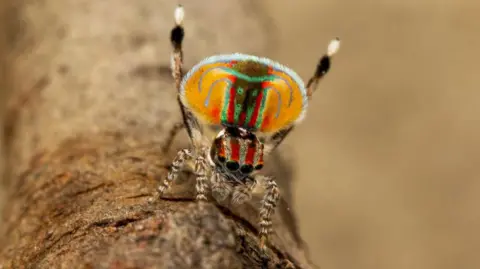AI Research
‘Dark DNA’ may explain dancing spiders’ extraordinary diversity

 Pallab GhoshScience Correspondent
Pallab GhoshScience CorrespondentIt’s not just the dazzling colours and slick moves of Australia’s dancing spiders that make them special.
There are more than 100 different species of the peacock spider, whereas most animals have only five or ten.
Researchers believe that’s partly down to the spider’s ‘dark DNA’ – a mysterious part of the animal’s genetic code, and they are studying it to find out more.
They think that this dark DNA might enable it to adapt rapidly to changing environmental circumstances by developing into new species.
What the scientists find out, they say, might help to explain why there is so much variation in the natural world.
“We are interested in how the spiders evolve to become that diverse,” Jonah Walker, of the Sanger Institute told BBC News.
“When you go outside you see so much variation in species of plants and animals,” he said.
“Peacock spiders are at the extreme end of that. And so, by studying them, we can use that extreme case to try to understand what processes produce variation in general.”
Peacock spiders are found across Australia and each one is the size of a pin head. It is so-named because of the brilliant colours males have on their abdomen, which they show off in a beguiling mating ritual.
They create a drumming sound with their feet, a spider song of sorts, and move rhythmically while displaying their dazzlingly patterned features. What is remarkable about these creatures is how varied they are in their appearance, songs and dance moves.
Mr Walker used to be scared of spiders, but he overcame his phobia because he was so drawn to the science behind the spiders and took the project on as part of his PhD research.
“When I told friends and family that I was going to study spiders in Australia I got some worried looks and I was obviously apprehensive myself. But just a few seconds of watching them dance was enough for any fears to be washed away.”
Mr Walker worked with his group leader, Dr Joana Meier and an international team to collect each and every one of the species discovered so far.
They then painstakingly categorised precise details about each one’s behaviour, movement and songs. The final piece of the jigsaw was to cross-reference all this information with the DNA of each species.
 Jonah Walker
Jonah WalkerBy comparing the results of each species, they hope to find out which genes are responsible for each trait and ultimately why there are so many different types of peacock spider.
The research is a work in progress but the team already has a strong scientific lead to investigate further.
“It is early days, but one of the tantalising things we have discovered is that it may not only be the genes that are responsible for the diversity, but the bits in between, the so-called ‘dark DNA’, that may influence how spiders evolve,” says Mr Walker.
DNA consists of a long string of molecules. Some parts of them are involved in deciding specific traits. In the case of humans they can decide height or eye colour. These sections are called genes.
But the bulk of the sections of DNA are not genes, and no one really knows what they do. The Sanger researchers think that this so-called dark DNA may be responsible for peacock spiders’ diversity.
They have three times more dark DNA than humans.
 Jonah Walker
Jonah WalkerSome butterflies and moths also have an exceptionally large number of species. Dr Meier has already decoded the DNA of a thousand species of butterflies and moths.
But spiders, butterflies and moths are just the start of one of the most ambitious genetic projects ever undertaken. The plan is to decipher the genetic code of every single plant, animal and fungus on the planet in the next 10 years.
“Just like all plants, animals and fungus we have very similar DNA,” Dr Meier told BBC News.
“By understanding the DNA of all the different organisms, we learn about the general principles of how genes work and what the function of dark DNA is, and so it also helps us find out a lot about ourselves”
Researchers have decoded the DNA of 3,000 different species so far as part of the Earth BioGenome Project.
The aim is to decode 10,000 next year and complete all 1.8 million living species in the next decade. The knowledge gained, scientists hope, will enable them to gain an unprecedented insight into how all living things evolved and the intricate interrelationships between them.
AI Research
YSU: Grant puts YSU at forefront of AI research – WFMJ.com
AI Research
Advarra launches AI- and data-backed study design solution to improve operational efficiency in clinical trials

Advarra, the market leader in regulatory reviews and a leading provider of clinical research technology, today announced the launch of its Study Design solution, which uses AI- and data-driven insights to help life sciences companies design protocols for greater operational efficiency in the real world.
Study Design solution evaluates a protocol’s feasibility by comparing it to similar trials using Braid™, Advarra’s newly launched data and AI engine. Braid is powered by a uniquely rich set of digitized protocol-related documents and operational data from over 30,000 historical studies conducted by 3,500 sponsors. Drawing on Advarra’s institutional review board (IRB) and clinical trial systems, this dataset spans diverse trial types and therapeutic areas, provides granular detail on schedules of assessment, and tracks longitudinal study modifications, giving sponsors deeper insights than solutions based only on in-house or public datasets.
“Too often, clinical trial protocols are developed without the benefit of robust comparative intelligence, leading to inefficient designs and operations,” said Laura Russell, senior vice president, head of data and AI product development at Advarra. “By drawing on the industry’s largest and richest operational dataset, Advarra’s Study Design solution delivers deeper insights into the feasibility of a protocol’s design. It helps sponsors better anticipate downstream operational challenges, make more informed decisions to simplify trial designs, and accelerate protocol development timelines.”
Advarra’s Study Design solution can be used to optimize a protocol prior to final submission or for retrospective analyses. The solution provides insights on design factors that drive operational feasibility, such as the impact of eligibility criteria, burdensomeness of the schedule of assessment on sites and participants, and reasons for amendments. Study teams receive custom benchmarking that allows for operational risk assessments through tailored data visualizations and consultations with Advarra’s data and study design experts. Technical teams can work directly within Advarra’s secure, self-service insights workspace to explore operational data for the purpose of powering internal analyses, models, and business intelligence tools.
“Early pilots have already demonstrated measurable impact,” added Russell. “In one engagement, benchmarking a sponsor’s protocol against comparable studies revealed twice as many exclusion criteria and 60 percent more site visits than industry benchmarks. With these insights, the sponsor saw a path to streamline future trial designs by removing unnecessary criteria, clustering procedures, and adopting hybrid visit models, ultimately reducing site burden and making participation easier for patients.”
Study Design solution is the first in a series of offerings by Advarra that will be powered by Braid. Future applications will extend insights beyond protocol design to improve study startup, enhance collaboration, and better support sites.
To learn more about Study Design solution or to request a consultation, visit advarra.com/study-design.
About Advarra
Advarra breaks the silos that impede clinical research, aligning patients, sites, sponsors, and CROs in a connected ecosystem to accelerate trials. Advarra is number one in research review services, a leader in site and sponsor technology, and is trusted by the top 50 global biopharma sponsors, top 20 CROs, and 50,000 site investigators worldwide. Advarra solutions enable collaboration, transparency, and speed to optimize trial operations, ensure patient safety and engagement, and reimagine clinical research while improving compliance. For more information, visit advarra.com.
AI Research
Best Artificial Intelligence (AI) Stock to Buy Now: Nvidia or Palantir?

Palantir has outperformed Nvidia so far this year, but investors shouldn’t ignore the chipmaker’s valuation.
Artificial intelligence (AI) investing is a remarkably broad field, as there are numerous ways to profit from this trend. Two of the most popular are Nvidia (NVDA -1.55%) and Palantir (PLTR -0.58%), which represent two different sides of AI investing.
Nvidia is on the hardware side, while Palantir produces AI software. These are two lucrative fields to invest in, but is there a clear-cut winner? Let’s find out.
Image source: Getty Images.
Palantir’s business model is more sustainable
Nvidia manufactures graphics processing units (GPUs), which have become the preferred computing hardware for processing AI workloads. While Nvidia has made a ton of money selling GPUs, it’s not done yet. Nvidia expects the big four AI hyperscalers to spend around $600 billion in data center capital expenditures this year, but projects that global data center capital expenditures will increase to $3 trillion to $4 trillion by 2030. That’s a major spending boom, and Nvidia will reap a substantial amount of money from that rise.
However, Nvidia isn’t completely safe. Its GPUs could fall out of style with AI hyperscalers as they develop in-house AI processing chips that could steal some of Nvidia’s market share. Furthermore, if demand for computing equipment diminishes, Nvidia’s revenue streams could fall. That’s why a subscription model like Palantir is a better business over the long term.
Palantir develops AI software that can be described as “data in, insights out.” By using AI to process a ton of information rapidly, Palantir can provide real-time insights for what those with decision-making authority should do. Furthermore, it also gives developers the power to deploy AI agents, which can act autonomously within a business.
Palantir sells its software to commercial clients and government entities, and has gathered a sizable customer base, although that figure is rapidly expanding. As the AI boom continues, these customers will likely stick with Palantir because it’s incredibly difficult to move away from the software once it has been deployed. This means that after the AI spending boom is complete, Palantir will still be able to generate continuous revenue from its software subscriptions.
This gives Palantir a business advantage.
Nvidia is growing faster
Although Palantir’s revenue growth is accelerating, it’s still slower than Nvidia’s.
NVDA Revenue (Quarterly YoY Growth) data by YCharts
This may invert sometime in the near future, but for now, Nvidia has the growth edge.
One item that could reaccelerate Nvidia’s growth is the return of its business in China. Nvidia is currently working on obtaining its export license for H20 chips. Once that is returned, the company could see a massive demand from another country that requires significant AI computing power. Even without a massive chunk of sales, Nvidia is still growing faster than Palantir, giving it the advantage here.
Nvidia is far cheaper than Palantir
With both companies growing at a similar rate, it would be logical to expect that they should trade within a similar valuation range. However, that’s not the case. Whether you analyze the stocks from a forward price-to-earnings (P/E) or price-to-sales (P/S) basis, Palantir’s stock is unbelievably expensive.
NVDA PE Ratio (Forward) data by YCharts
From a P/S basis, Palantir is about 5 times more expensive than Nvidia. From a forward P/E basis, it’s about 6.5 times more expensive.
With these two growing at the same rate, this massive premium for Palantir’s stock doesn’t make a ton of sense. It will take years, or even a decade, at Palantir’s growth rate to bring its valuation down to a reasonable level; yet, Nvidia is already trading at that price point.
I think this gives Nvidia an unassailable advantage for investors, and I think it’s the far better buy right now, primarily due to valuation, as Palantir’s price has gotten out of control.
Keithen Drury has positions in Nvidia. The Motley Fool has positions in and recommends Nvidia and Palantir Technologies. The Motley Fool has a disclosure policy.
-

 Business3 weeks ago
Business3 weeks agoThe Guardian view on Trump and the Fed: independence is no substitute for accountability | Editorial
-
Tools & Platforms1 month ago
Building Trust in Military AI Starts with Opening the Black Box – War on the Rocks
-

 Ethics & Policy2 months ago
Ethics & Policy2 months agoSDAIA Supports Saudi Arabia’s Leadership in Shaping Global AI Ethics, Policy, and Research – وكالة الأنباء السعودية
-

 Events & Conferences4 months ago
Events & Conferences4 months agoJourney to 1000 models: Scaling Instagram’s recommendation system
-

 Jobs & Careers3 months ago
Jobs & Careers3 months agoMumbai-based Perplexity Alternative Has 60k+ Users Without Funding
-

 Podcasts & Talks2 months ago
Podcasts & Talks2 months agoHappy 4th of July! 🎆 Made with Veo 3 in Gemini
-

 Education2 months ago
Education2 months agoMacron says UK and France have duty to tackle illegal migration ‘with humanity, solidarity and firmness’ – UK politics live | Politics
-

 Education3 months ago
Education3 months agoVEX Robotics launches AI-powered classroom robotics system
-

 Podcasts & Talks2 months ago
Podcasts & Talks2 months agoOpenAI 🤝 @teamganassi
-

 Funding & Business3 months ago
Funding & Business3 months agoKayak and Expedia race to build AI travel agents that turn social posts into itineraries





